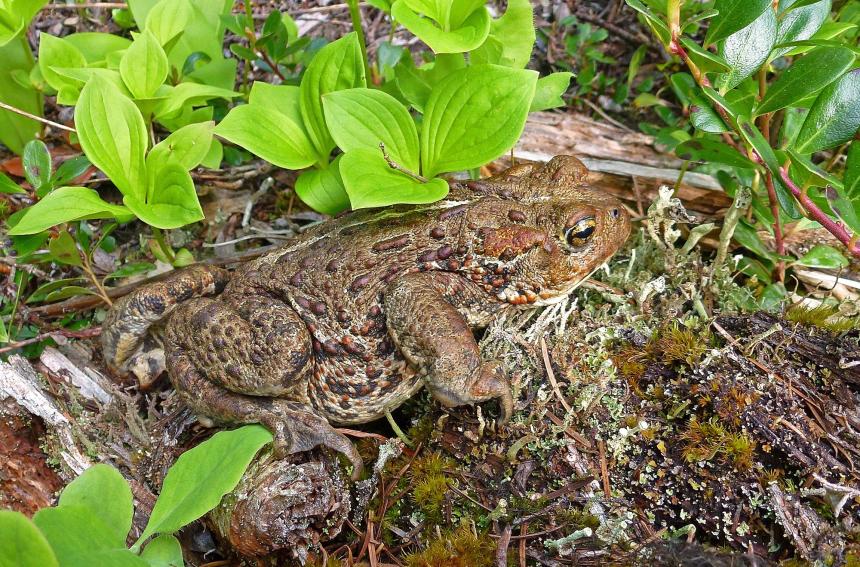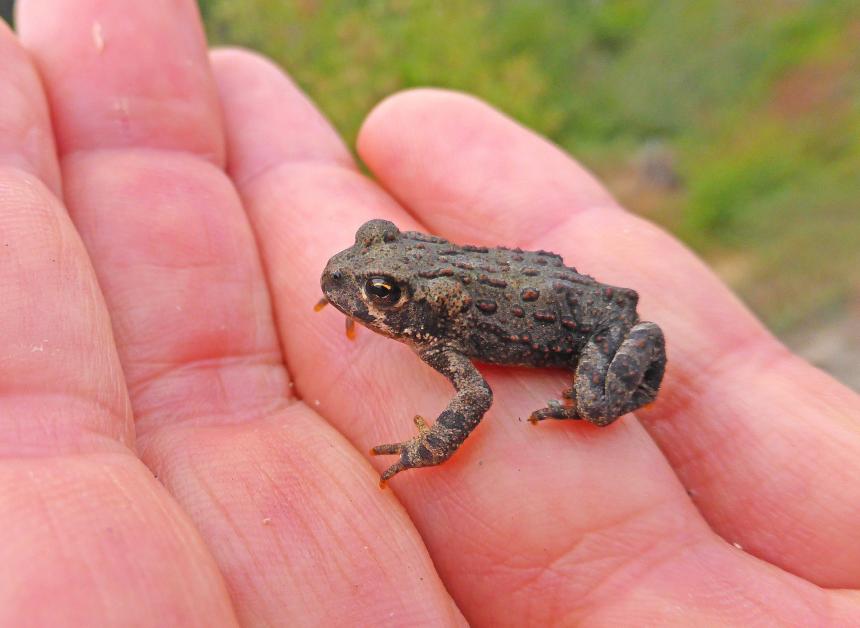Moderate-
High
This toad’s population is unknown in the Puget Sound lowland and in lower Columbia River below the Bonneville Dam; only 19 out of 107 historical sites in these areas that remain, however, the species is locally common elsewhere in Washington.
Description and Range
Physical description
This is a medium-sized to large toad with a blunt head, stout body, broad waist, short legs, and “warty” skin. Adults range in size from 2 to 5 inches in length. Females attain larger sizes than males. Prominent oval glands (parotoid glands) are present on the head behind the eyes. The dorsal (topside) of the body may be brown, green, olive, gray, or reddish-brown. The warts are usually surrounded by dark blotches and may be reddish. A distinct, thin, light stripe runs along the middle of the back from top of the head to the rear end. The underside is light with irregularly distributed dark markings. The pupil of the eye is horizontal oval.
During the breeding season, males develop a smoother skin than females.
These traits are not present in newly metamorphosed toads and may not be prominent in juvenile toads. Newly metamorphosed toads emerge from the water with remnants of the tail and dark skin. Within days they develop the appearance of miniature adults except the parotoid glands are not as obvious and the dorsal stripe may be subtle or absent.
Presence of parotoid glands distinguishes True Toads (Bufonidae) from all other frogs. In comparison with western toads, Woodhouse’s toads (Bufo woodhousii) have elongate parotoid glands that are distinctly longer than the eye and have “L”-shaped cranial crests located between and posterior to the eyes.
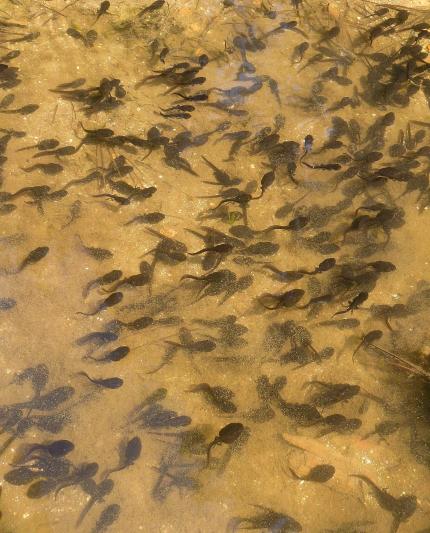
Larvae
The tadpole is uniformly dark and appears black in water. Varying degrees of fine lighter flecking are present on the body. The body is dorsally flattened with a low tail fin that originates at the dorsal tail-body junction. The eyes are dorsally situated relatively high on the head. The spiracle is on the left side of the body and the vent is medial at the tail-body juncture. The tail musculature is dark, and the fins are slightly pigmented with the dorsal fin darker than the ventral. The tail tip is rounded. The underside of the body is slightly paler than the dorsal surface. The fine lighter flecking on larger tadpoles gives them a fine golden shimmer over the belly when viewed in bright light. Tadpoles grow to approximately 2 inches total length. The tadpoles form dense aggregations or “schools” composed of thousands of individuals that consist of kin groups (siblings from the same clutch).
The tadpoles of both western and Woodhouse’s toad species are similar, but Woodhouse’s toad tadpoles have patches of white and gold pigment on the body and the underside of the tail musculature and the tail fin lacks pigment except for some dark flecking.
Eggs
The eggs are laid in long strings on bare sediments or intertwined in vegetation in shallow water near shore. Individual females produce approximately 12,000 eggs per clutch on average (estimated counts range 6,000 to 20,000). Toads have been observed to wrap their eggs around vegetation in deeper water (greater than 3 feet) away from shore, but this is not typical.
The egg strings are similar to Woodhouse’s toads but the latter has only one gel layer.
Voice
The adult western toad emits a mellow chirruping or soft, high pitched plinking sound like the peeping of a chick. These vocalizations are produced with notes in rapid succession. Multiple males vocalizing at the same time sound rather like a distant flock of cackling Canada geese. Vocalizations are produced day and night. One must be relatively close (less than 100 feet) to hear them. Both males and spent females give a “release call” when grabbed by an indiscriminate male or when handled by humans. This call is a rapid chirping accompanied by a pulsing of the body. Listen to the calls of western toad in this short video clip.
In comparison, the call of Woodhouse’s toads is a loud, explosive “w-a-a-a-a-ah” lasting about 1 to 1 1/2 seconds
For more details about western toad, see the Washington Herp Atlas (PDF).
Ecology and life history
This species occurs in a variety of terrestrial habitats including prairies, forests, canyon grasslands and ponderosa pine-Oregon oak habitat. They appear absent from most of the shrubsteppe and steppe zones with the exception of the canyon grasslands in southeast Washington. Breeding waters are usually permanent and include wetlands, ponds, lakes, reservoir coves and the still-water off-channel habitats of rivers, as well as river edges.
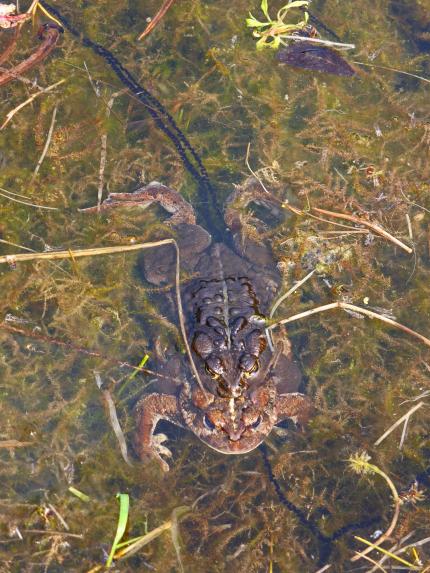
In lowland western Washington, individual toads have been found in mid-February within duff under sword ferns suggesting that some individuals overwinter terrestrially in areas with mild winters or at least occur terrestrially during the mild portions of winters.
Western toads eat a variety of invertebrates, mostly insects, but also worms. Tadpoles eat algae and detritus (organic material) in the aquatic environment.
In general, breeding starts in mid-April at low elevation sites in western Washington and in late April or early May at low elevation sites in eastern Washington. Toads at higher elevations tend to breed later.
Toads breed in the still waters of lakes and ponds, but they also breed within slower moving sections of rivers. Onset of egg laying at each location varies from one to three weeks each year depending on site conditions such as snow melt.
Tadpole development to metamorphosis takes approximately two months depending on temperature and food availability. Watch this amazing underwater footage of masses of western toad tadpoles during their aquatic journey and metamorphosis into toadlets.
The newly metamorphosed toads disperse from the breeding sites in groups for 1 to 2 weeks. Informal observations indicate that many populations return to the same breeding location each year. Transformed toads are primarily terrestrial, but often occur near water bodies, especially in drier climates.
Western toads can produce a poisonous substance from their skin, which helps protect them from predators.
Geographic range
Western toads occur in all nine Washington ecoregions: Northwest Coast, West Cascades, Puget Trough, North Cascades, Columbia Plateau, Okanogan, East Cascades, Canadian Rocky Mountains, and Blue Mountains. Ecoregions are broad areas that share similar flora and fauna, geology, hydrology, and landforms. Within the Washington portion of the Columbia Plateau, the species’ distribution is limited to the edges of the ecoregion except in the southeast corner of the state. The toads are locally abundant in some areas, but local declines have been documented in others.
This map from the Washington Herp Atlas illustrates the distribution of western toad in Washington based on records in the WDFW database as of 2016. If you see this species in areas that are not indicated on the map or have more recent observations (less than 10 years), please share your observation using the WDFW wildlife reporting form.
For maps of range-wide distribution and conservation status of this species, check out NatureServe Explorer and the International Union for Conservation of Nature Red List.
Climate vulnerability
Sensitivity to climate change
Moderate-
High
Sensitivity of the western toad to climate change is primarily driven by its dependence on intermittent and permanent aquatic habitats (e.g., streams, seeps, wetlands, ponds, etc.) that may be lost or degraded due to changes in precipitation and altered hydrology. A significant portion of western toad breeding in western Washington occurs in low-gradient portions of rivers, such as the Chehalis and its tributaries, after the hydrographs have dropped to a level that is unlikely to risk scouring their unattached eggs. Greater, more variable, and episodic rainfall (all current predictions of climate change in the PNW) are likely to put these river-breeding populations at risk. High-elevation populations may be at risk because of reduced hydroperiods in breeding habitat that result either in reproductive failure or eliminate that ability of a significant portion of annual cohorts to reach metamorphosis. Desiccation of streams and pools along dispersal routes may create barriers to movement. Synergistic impacts such as climate changes combined with disease outbreaks increases sensitivity of this species. Physiological sensitivity of this species is unclear - some references cite sensitivities to temperature and moisture conditions while others cite high adaptability to changes in these conditions.
Exposure to climate change
Moderate-
High
- Changes in precipitation (rain and snow)
- Altered hydrology
- Greatest impacts to montane wetland-reliant taxa will most likely occur when landscapes primarily contain shallow wetlands at high risk of drying and are composed of multiple wetland types but deeper habitats are unsuitable (e.g., due to presence of introduced fish)
Regulations
Licenses and permits
Be advised that collection of this species is only permitted under a WDFW Scientific Collection Permit for research and educational activities.
Conservation
Note: WDFW’s SGCN classification only applies to western toads in the Puget Trough Ecoregion.
Conservation Threats and Actions Needed
- Fish and wildlife habitat loss or degradation
- Threat: Transportation and service corridors – roads and railroads.
- Action Needed: Avoid road building near breeding sites.
- Threat: Road mortality when moving to and from breeding sites. Newly metamorphosed toads disperse en masse and gather in piles. When this happens on roads, thousands of toads can be killed by a single vehicle. Adults are also killed as they move to and from breeding sites.
- Action Needed: 1. Identify and map known crossings; 2. Avoid road building near breeding sites; 3; When possible, close roads to vehicles during dispersal periods (e.g., ATV use on gated dirt roads); 4. Create passage structures to circumvent roads.
- Threat: Loss of upland habitat through the development on shorelines and around water bodies used for breeding.
- Action Needed: Protect known pockets of abundance and breeding areas.
- Threat: Habitat alteration and degradation.
- Action Needed: Protect known pockets of abundance and breeding areas.
- Resource information collection needs
- Threat: Lack of information on status and distribution.
- Action Needed: Research, surveys, and monitoring to understand species distribution and status.
- Threat: Taxonomic uncertainty may mean one or more taxa are in greater decline; causes of decline are not understood.
- Action Needed: Conduct genetic studies.
- Invasive and other problematic species
- Threat: Chytrids and other fungi, and parasites have contributed to declines throughout the species’ range; however, chytrids have not yet been detected in Washington toads.
- Action Needed: Include testing for chytrids, fungal infections, and trematode infections in survey and monitoring protocols.
See the Climate vulnerability section for information about the threats posed by climate change to this species.
Our Conservation Efforts
The Washington Connected Landscapes Project
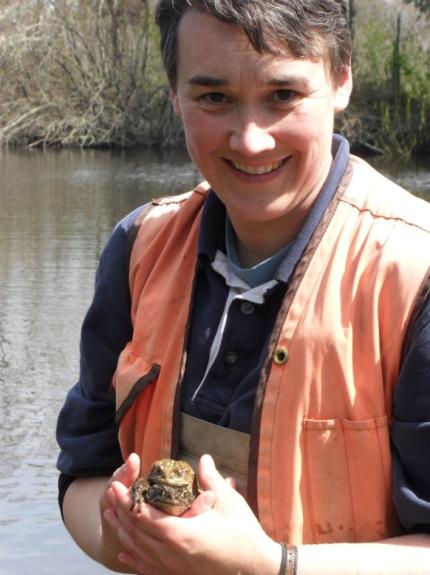
WDFW participated in the Washington Wildlife Habitat Connectivity Working Group, formed in 2007, whose mission was to promote the long-term viability of wildlife populations in Washington State through a science-based, collaborative approach that identified opportunities and priorities to conserve and restore habitat connectivity. Other participants were:
- Washington State Department of Transportation
- Washington Department of Natural Resources
- The Nature Conservancy
- U.S. Dept. of Agriculture – Forest Service
- U.S. Fish and Wildlife Service
- University of Washington
- Montana State University – Western Transportation Institute
This working group initiated the Washington Connected Landscapes Project, which provided a systematic approach with multiple components and a sustained effort to support the group’s mission. They produced a statewide analysis, published in 2010. This analysis quantified current connectivity patterns at three different spatial scales for Washington State and neighboring areas in British Columbia, Idaho, and Oregon.
Assessing the current condition of wildlife habitat connectivity in the state was an important step for connectivity conservation. Animals move across landscapes to find food and other resources, migrate between seasonal habitats, find mates, and shift to new habitats in response to environmental changes. The ability to successfully move between habitats is essential for the long-term survival of many wildlife species, from large, migratory species such as elk and mule deer, to smaller animals like white-tailed jackrabbits, greater sage-grouse, and western toads.
Focal wildlife species were selected using criteria designed to favor species with geographic ranges, habitat associations, and vulnerabilities to human-created barriers that made them representative of the habitat connectivity needs of many terrestrial species at a statewide scale. Western toads were selected as a focal species because they were a good representative of habitat connectivity needs of wildlife with similar life history needs in the three forest vegetation classes (Rocky Mountain, Vancouverian, and Subalpine Forests). In addition, the toads‘ broad coverage across the landscape, reliance on connectivity between populations, and in particular, their association with wetlands and aquatic systems led to inclusion in the statewide analysis. Check out the analysis for more details.
Resources
References
Bartelt, P. E., C. R. Peterson, and R. W. Klaver. 2004. Sexual differences in the post-breeding movements and habitats selected by western toads (Bufo boreas) in southeastern Idaho. Herpetologica 60(4): 455-467.
Davidson, C. 1995. Frog and Toad Calls of the Pacific Coast: Vanishing Voices. Library of Natural Sounds, Cornell University Laboratory of Ornithology, Library of Natural Sound.
Hallock, L. A. and W. P. Leonard. 1997. Inventory of the Ft. Lewis Military Reservation. Unpubl. Rep. Wash. Natural Heritage Program, Dept. of Natural Resources, Olympia. 52 pp. + appendices.
Maxell, B. A., K. J. Nelson and S. Browder. 2002. Record clutch size and observations on breeding and development of the Western Toad (Bufo boreas) in Montana. Northwestern Naturalist 83:27-30.
Nussbaum, R. A., E. D. Brodie, Jr., and R.M. Storm. 1983. Amphibians and Reptiles of the Pacific Northwest. University of Idaho Press, Moscow, Idaho. 332 pp.
Samollow, P. B. 1980. Selective mortality and reproduction in a natural population of Bufo boreas. Evolution. 34(1):18-39.
Stebbins. R. C. 2003. A Field Guide to Western Reptiles and Amphibians, 3rd Edition. The Peterson Field Guide Series. Houghton Mifflin Company, Boston. 533 pp.
Stebbins, R. C. and N. W. Cohen. 1995. A Natural History of Amphibians. Princeton University Press, Princeton, New Jersey, 316 pp.
Personal communications
Charlie Crisafulli, PNW Research Station, USDA Forest Service, Olympia, Washington.
Tara Chestnut, Washington Department of Transportation, Olympia, Washington.
Marc Hayes, Washington Department of Fish and Wildlife, Olympia, Washington.
William (Bill) Leonard, Washington Department of Transportation, Olympia, Washington.
Ruth Milner, Washington Department of Fish and Wildlife, Mill Creek, Washington.
WDFW publications
-
Hallock, L.A. and K.R. McAllister. 2005. Western Toad. Washington Herp Atlas. 2009. A cooperative effort of Washington Natural Heritage Program, Washington Department of Fish and Wildlife, U.S.D.I. Bureau of Land Management, and U.S. Forest Service. Map products updated March 2017. Provisional PDF version of the website (2005-2019) created July 2019. 250 pp.
PHS Program
WDFW educational resources
- Wild Washington Lesson Plan – Herps in Washington - Elementary school students are introduced to the cold-blooded world of reptiles and amphibians, also known as herps.
- Family Education – Amphibians and Reptiles - Slither, hop, or crawl on over to learn about herpetofauna!
